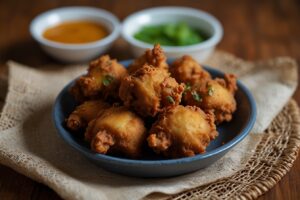Starting a food blog can be an exciting and rewarding venture. Whether you’re passionate about cooking, and baking, or love trying new restaurants, a food blog allows you to share your culinary experiences with a wider audience. This guide will walk you through the steps to create a successful food blog, from inception to monetization.
Step 1: Define Your Niche
Before diving into the technical aspects, defining your niche is crucial. A niche helps you target a specific audience and makes your blog stand out. Consider what you are passionate about and where you can offer unique insights. Some popular food blog niches include:

Recipes: Focus on creating and sharing original recipes.
Restaurant Reviews: Share your experiences dining out.
Healthy Eating: Provide tips and recipes for a healthier lifestyle.
Vegan/Vegetarian: Cater to plant-based diets.
Baking: Specialize in desserts and baked goods.
Ethnic Cuisine: Highlight recipes from a specific culture or region.
Step 2: Choose a Blog Name
Your blog name should be memorable, easy to spell, and reflective of your niche. Take your time brainstorming and checking the availability of your chosen name. Ensure that the domain name is available for your blog.
Step 3: Set Up Your Blog
Choose a Blogging Platform
The most popular blogging platform is WordPress.org due to its flexibility and customization options. However, depending on your needs, other platforms like Blogger, Wix, or Squarespace can also be suitable.
Get Web Hosting
If you choose WordPress.org, you’ll need web hosting. Some popular hosting providers include:
Bluehost
SiteGround
HostGator
Choose a hosting plan that suits your budget and requirements.
Install WordPress
Most hosting providers offer one-click WordPress installation. Follow the prompts to install WordPress on your domain.
Step 4: Design Your Blog
Choose a Theme
Your blog’s design should be visually appealing and user-friendly. WordPress offers thousands of free and premium themes. Some popular themes for food blogs include:
Foodica
Cookely
Neve
Customize Your Theme
Once you’ve chosen a theme, customize it to match your brand. This includes adding your logo, changing color schemes, and setting up your menu.
Step 5: Install Essential Plugins
Plugins add functionality to your WordPress blog. Some essential plugins for a food blog include:
Yoast SEO: For search engine optimization.
WP Recipe Maker: To create and display recipes.
kismet: To protect your blog from spam comments.
Social Snap: For social media sharing buttons.
Smush: For image optimization.
Step 6: Create High-Quality Content
Content is the heart of your blog. Focus on creating valuable, engaging, and visually appealing content.
Write Engaging Blog Posts
Each post should have a clear structure, including an introduction, body, and conclusion. Use headings, bullet points, and short paragraphs to make your posts easy to read.
Share Original Recipes
If your blog focuses on recipes, ensure they are easy to follow and include step-by-step instructions, ingredient lists, and cooking times. Include personal tips and variations to add value.
Use High-Quality Images
Food blogging relies heavily on visuals. Invest in a good camera or smartphone and learn basic food photography techniques. Edit your photos to enhance their appeal, but keep them realistic.

Step 7: Optimize for SEO
Search engine optimization (SEO) helps your blog rank higher in search engine results, driving organic traffic to your site.
Keyword Research
Use tools like Google Keyword Planner, SEMrush, or Ahrefs to find keywords related to your niche. Focus on less competitive long-tail keywords.
On-Page SEO
Title Tags: Include your main keyword in the title.
Meta Descriptions: Write compelling meta descriptions with keywords.
Headings: Use H1 for your main title and H2, and H3 for subheadings.
Alt Text: Add alt text to your images with relevant keywords.
Internal Linking: Link to other relevant posts within your blog.
Step 8: Promote Your Blog
Creating content is just the beginning. Promotion is key to growing your audience.
Social Media
Share your posts on social media platforms like Instagram, Facebook, Pinterest, and Twitter. Each platform has its strengths; for instance, Instagram and Pinterest are great for visual content, while Facebook is ideal for building a community.
Email Marketing
Build an email list from day one. Offer a freebie, like an eBook or exclusive recipes, to encourage sign-ups. Email marketing tools like Mailchimp or ConvertKit can be used to send regular newsletters.
Collaborations
Collaborate with other bloggers and influencers in your niche. Guest posting, social media takeovers, and joint giveaways can help you reach a broader audience.
Step 9: Engage with Your Audience
Building a loyal audience requires engagement. Respond to comments on your blog and social media, ask for feedback, and create interactive content like polls or Q&A sessions.
Step 10: Monetize Your Blog
Once you have a steady stream of traffic, you can start monetizing your blog.
Ad Networks
Join ad networks like Google AdSense or Mediavine to display ads on your blog. You’ll earn revenue based on clicks or impressions.
Affiliate Marketing
Promote products you use and love through affiliate marketing. Sign up for affiliate programs like Amazon Associates or ShareASale, and include affiliate links in your posts. You’ll earn a commission for every sale made through your link.
Sponsored Posts
Work with brands to create sponsored content. This can include product reviews, recipe development, or social media posts. Ensure any sponsored content aligns with your blog’s values and audience.
Sell Digital Products
Create and sell digital products like eBooks, online courses, or meal plans. These products can provide significant income and establish you as an authority in your niche.
Step 11: Analyze and Improve
Regularly analyze your blog’s performance to understand what works and what doesn’t.
Use Analytics Tools
Google Analytics is a powerful tool that provides insights into your audience, traffic sources, and content performance. Use it to track metrics like page views, bounce rate, and average session duration.
Optimize Your Strategy
Based on your analytics, tweak your content and promotion strategies. Focus on creating more of what resonates with your audience and continuously improve your SEO efforts.
Step 12: Stay Consistent and Patient
Building a successful food blog takes time and effort. Consistency is key. Regularly publish high-quality content, engage with your audience, and stay updated with industry trends.
Conclusion
Starting a successful food blog involves careful planning, dedication, and a passion for sharing culinary adventures. By following this step-by-step guide, you’ll be well on your way to creating a food blog that attracts a loyal audience and generates income. Remember, the journey is as delicious as the destination. Happy blogging!
Related Post You Like
How to Make Money on Social Media: 10 Ideas for 2024
20 Ways to Make Money Online as a Teen
How to Earn Money with Constant Contact
How to Make $100 Per Day from Blogging in (2024)
How To Start a Tech Blog That Makes Money in 2024 step-by-step guide
How to Grow Your Blog in 10 Easy Steps
How to Make Money as a Food Blogger with These 15 Ways in 2024


